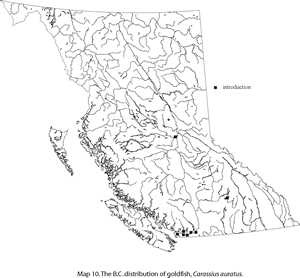Dorsal spines (total): 3 - 4; Dorsal soft rays (total): 14 - 20; Anal spines: 2 - 3; Anal soft rays: 4 - 7; Vertebrae: 30. Body stout, thick-set, caudal peduncle thick and short (Ref. 1998). Head without scales (Ref. 39167, 1998), broadly triangular (Ref. 1998), interorbital space broad, snout longer than eye diameter, maxillary reaching posterior nostril or not quite to eye (Ref. 39166), barbels lacking on upper jaw (Ref. 39104, 1998). Lateral line complete. Dorsal and anal fins with serrate bony spines, pelvic fins short, broad and thoracic. Nuptial tubercles of male fine, on opercle, sometimes on back and a few on pectoral fins. Hybridize readily with carp, hybrids intermediate in most characteristics (Ref. 1998). Caudal fin with 17-19 rays (Ref. 2196). Last simple anal ray osseous and serrated posteriorly; no barbels (Ref. 43281). Pigmentation: Wild-caught specimens, olive brown (Ref. 39168, 39104), slate olive, olive green, with a bronze sheen (Ref. 39104), silvery, grayish yellowish, gray-silver (Ref. 39169), through gold (often with black blotches) to creamy white (Ref. 1998); yellowish white or white below. Cultured forms vary through scarlet, red-pink, silver, brown, white, black and combinations of these colors (Ref. 39104).
Goldfish
Family: Cyprinidae
Introduction
|
Species Information
Biology
|
Distribution
|
BC Distribution and Notes In B.C., this common aquarium fish is regularly released into the wild; however, it rarely establishes feral populations. Typically, feral populations are associated with small lakes, ponds, or sluggish sloughs in parks, golf courses and housing developments. They often are associated with dense vegetation and waters with a strong diel oxygen pulse. Goldfish can tolerate a wide range of temperatures and are unaffected by ice cover; however, they require water of 15–25ºC to breed. Consequently, they are unlikely to establish self-sustaining populations in central or northern B.C. Source: Information provided by Don McPhail for E-Fauna BC. Global Distribution Asia: central Asia and China, and Japan (Ref. 6390). Introduced throughout the world. Asian form of the goldfish (Ref. 1739). Several countries report adverse ecological impact after introduction. Source: FishBase. Kottelat, M., A.J. Whitten, S.N. Kartikasari and S. Wirjoatmodjo 1993 Freshwater fishes of Western Indonesia and Sulawesi. Periplus Editions, Hong Kong. 221 p. |
Status Information
|
BC Ministry of Environment: BC Species and Ecosystems Explorer--the authoritative source for conservation information in British Columbia. |
